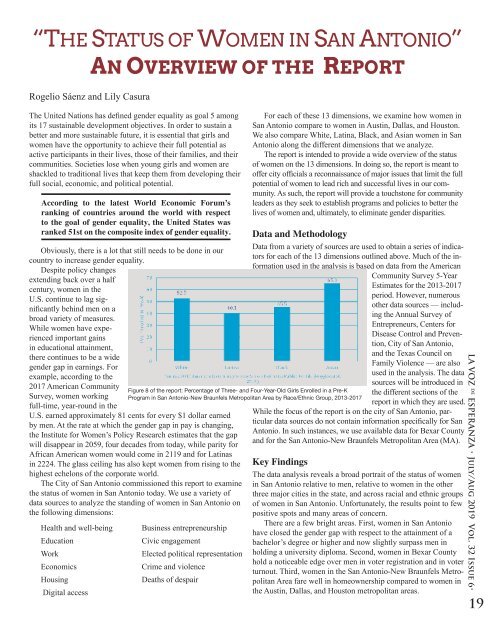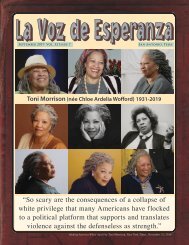La Voz - July Aug 2019
A National Emergency: To Protect & Preserve the Rio Grande by Melissa R. Cigarroa and Tricia Cortez • Traduire les Frontières/Translating Borders by Norma Cantú • (Our Lady of the Lake English/Creative Writing/Social Justice submissions: Prayer in the Shape of a Gun by s.t.shimi, The Noise of Highway 90 by Larissa Hernández, Rice by Emily Yglesias, Nuestro Westside by Samantha Ceballos • The Dungeons by Josefina Beatriz Longoria • Asylum by Arrie B. Porter) • WRITING ON THE WALL: Zapata County residents speak up about the wall; prospect of losing land evokes greater good takings for 1950s Falcon Dam construction by Maria Eugenia Guerra • Re-Rethinking Impeachment After the Mueller Report by Elliot Benjamin, Ph.D. • “The Status of Women in San Antonio”: An Overview Of The Report by Rogelio Sáenz and Lily Casura • Low Income Tenants Organizing For Justice by Pancho Valdez & James Hamilton
A National Emergency: To Protect & Preserve the Rio Grande by Melissa R. Cigarroa and Tricia Cortez • Traduire les Frontières/Translating Borders by Norma Cantú • (Our Lady of the Lake English/Creative Writing/Social Justice submissions: Prayer in the Shape of a Gun by s.t.shimi, The Noise of Highway 90 by Larissa Hernández, Rice by Emily Yglesias, Nuestro Westside by Samantha Ceballos • The Dungeons by Josefina Beatriz Longoria • Asylum by Arrie B. Porter) • WRITING ON THE WALL: Zapata County residents speak up about the wall; prospect of losing land evokes greater good takings for 1950s Falcon Dam construction by Maria Eugenia Guerra • Re-Rethinking Impeachment After the Mueller Report by Elliot Benjamin, Ph.D. • “The Status of Women in San Antonio”: An Overview Of The Report by Rogelio Sáenz and Lily Casura • Low Income Tenants Organizing For Justice by Pancho Valdez & James Hamilton
You also want an ePaper? Increase the reach of your titles
YUMPU automatically turns print PDFs into web optimized ePapers that Google loves.
“The Status of Women in San Antonio”<br />
Rogelio Sáenz and Lily Casura<br />
An Overview of the Report<br />
The United Nations has defined gender equality as goal 5 among<br />
its 17 sustainable development objectives. In order to sustain a<br />
better and more sustainable future, it is essential that girls and<br />
women have the opportunity to achieve their full potential as<br />
active participants in their lives, those of their families, and their<br />
communities. Societies lose when young girls and women are<br />
shackled to traditional lives that keep them from developing their<br />
full social, economic, and political potential.<br />
According to the latest World Economic Forum’s<br />
ranking of countries around the world with respect<br />
to the goal of gender equality, the United States was<br />
ranked 51st on the composite index of gender equality.<br />
Obviously, there is a lot that still needs to be done in our<br />
country to increase gender equality.<br />
Despite policy changes<br />
extending back over a half<br />
century, women in the<br />
U.S. continue to lag significantly<br />
behind men on a<br />
broad variety of measures.<br />
While women have experienced<br />
important gains<br />
in educational attainment,<br />
there continues to be a wide<br />
gender gap in earnings. For<br />
example, according to the<br />
2017 American Community<br />
Survey, women working<br />
full-time, year-round in the<br />
U.S. earned approximately 81 cents for every $1 dollar earned<br />
by men. At the rate at which the gender gap in pay is changing,<br />
the Institute for Women’s Policy Research estimates that the gap<br />
will disappear in 2059, four decades from today, while parity for<br />
African American women would come in 2119 and for <strong>La</strong>tinas<br />
in 2224. The glass ceiling has also kept women from rising to the<br />
highest echelons of the corporate world.<br />
The City of San Antonio commissioned this report to examine<br />
the status of women in San Antonio today. We use a variety of<br />
data sources to analyze the standing of women in San Antonio on<br />
the following dimensions:<br />
Health and well-being<br />
Education<br />
Work<br />
Economics<br />
Housing<br />
Digital access<br />
Business entrepreneurship<br />
Civic engagement<br />
Elected political representation<br />
Crime and violence<br />
Deaths of despair<br />
For each of these 13 dimensions, we examine how women in<br />
San Antonio compare to women in Austin, Dallas, and Houston.<br />
We also compare White, <strong>La</strong>tina, Black, and Asian women in San<br />
Antonio along the different dimensions that we analyze.<br />
The report is intended to provide a wide overview of the status<br />
of women on the 13 dimensions. In doing so, the report is meant to<br />
offer city officials a reconnaissance of major issues that limit the full<br />
potential of women to lead rich and successful lives in our community.<br />
As such, the report will provide a touchstone for community<br />
leaders as they seek to establish programs and policies to better the<br />
lives of women and, ultimately, to eliminate gender disparities.<br />
Data and Methodology<br />
Data from a variety of sources are used to obtain a series of indicators<br />
for each of the 13 dimensions outlined above. Much of the information<br />
used in the analysis is based on data from the American<br />
Community Survey 5-Year<br />
Estimates for the 2013-2017<br />
period. However, numerous<br />
other data sources — including<br />
the Annual Survey of<br />
Entrepreneurs, Centers for<br />
Disease Control and Prevention,<br />
City of San Antonio,<br />
and the Texas Council on<br />
Family Violence — are also<br />
used in the analysis. The data<br />
sources will be introduced in<br />
the different sections of the<br />
report in which they are used.<br />
While the focus of the report is on the city of San Antonio, particular<br />
data sources do not contain information specifically for San<br />
Antonio. In such instances, we use available data for Bexar County<br />
and for the San Antonio-New Braunfels Metropolitan Area (MA).<br />
Figure 8 of the report: Percentage of Three- and Four-Year-Old Girls Enrolled in a Pre-K<br />
Program in San Antonio-New Braunfels Metropolitan Area by Race/Ethnic Group, 2013-2017<br />
Key Findings<br />
The data analysis reveals a broad portrait of the status of women<br />
in San Antonio relative to men, relative to women in the other<br />
three major cities in the state, and across racial and ethnic groups<br />
of women in San Antonio. Unfortunately, the results point to few<br />
positive spots and many areas of concern.<br />
There are a few bright areas. First, women in San Antonio<br />
have closed the gender gap with respect to the attainment of a<br />
bachelor’s degree or higher and now slightly surpass men in<br />
holding a university diploma. Second, women in Bexar County<br />
hold a noticeable edge over men in voter registration and in voter<br />
turnout. Third, women in the San Antonio-New Braunfels Metropolitan<br />
Area fare well in homeownership compared to women in<br />
the Austin, Dallas, and Houston metropolitan areas.<br />
LA VOZ de ESPERANZA • <strong>July</strong>/<strong>Aug</strong> <strong>2019</strong> Vol. 32 Issue 6•<br />
19





